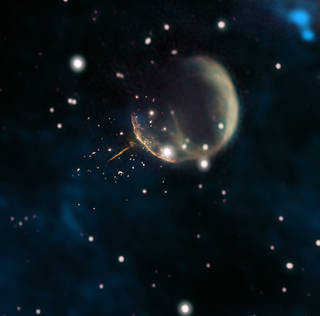
The CTB 1 supernova remnant resembles a ghostly bubble in this image, which combines new 1.5 gigahertz observations from the Very Large Array (VLA) radio telescope (orange, near center) with older observations from the Dominion Radio Astrophysical Observatory’s Canadian Galactic Plane Survey (1.42 gigahertz, magenta and yellow; 408 megahertz, green) and infrared data (blue). Credits: Composite by Jayanne English, University of Manitoba, using data from NRAO/F. Schinzel et al., DRAO/Canadian Gala
WASHINGTON
NASA has discovered a pulsar hurtling through space at nearly four million kilometres an hour—so fast that it could travel the distance between Earth and the Moon in just six minutes.
Pulsars are superdense, rapidly spinning neutron stars left behind when a massive star explodes.
This one, dubbed PSR J0002+6216 (J0002 for short), sports a radio-emitting tail pointing directly toward the expanding debris of a recent supernova explosion, NASA said in a statement.
"Thanks to its narrow dart-like tail and a fortuitous viewing angle, we can trace this pulsar straight back to its birthplace," said Frank Schinzel, a scientist at the National Radio Astronomy Observatory (NRAO) in the US.
"Further study of this object will help us better understand how these explosions are able to 'kick' neutron stars to such high speed," said Schinzel.
Pulsar J0002 was discovered in 2017 by a citizen-science project called Einstein@Home, which uses time on the computers of volunteers to process Fermi gamma-ray data.
Thanks to computer processing time collectively exceeding 10,000 years, the project has identified 23 gamma-ray pulsars to date, NASA said.
Located about 6,500 light-years away in the constellation Cassiopeia, J0002 spins 8.7 times a second, producing a pulse of gamma rays with each rotation.
The pulsar lies about 53 light-years from the centre of a supernova remnant called CTB 1. Its rapid motion through interstellar gas results in shock waves that produce the tail of magnetic energy and accelerated particles detected at radio wavelengths using the VLA.
The tail extends 13 light-years and clearly points back to the centre of CTB 1.
The team was able to measure how quickly and in what direction the pulsar is moving across our line of sight.
The result supports the idea that the pulsar was kicked into high speed by the supernova responsible for CTB 1, which occurred about 10,000 years ago.
J0002 is speeding through space five times faster than the average pulsar, and faster than 99 per cent of those with measured speeds. It will eventually escape our galaxy, researchers said.
At first, the supernova's expanding debris would have moved outward faster than J0002, but over thousands of years the shell's interaction with interstellar gas produced a drag that gradually slowed this motion.
Meanwhile, the pulsar, behaving more like a cannonball, steadily raced through the remnant, escaping it about 5,000 years after the explosion.
Exactly how the pulsar was accelerated to such high speed during the supernova explosion remains unclear, and further study of J0002 will help shed light on the process.
One possible mechanism involves instabilities in the collapsing star forming a region of dense, slow-moving matter that survives long enough to serve as a "gravitational tugboat," accelerating the nascent neutron star toward it. — PTI



























